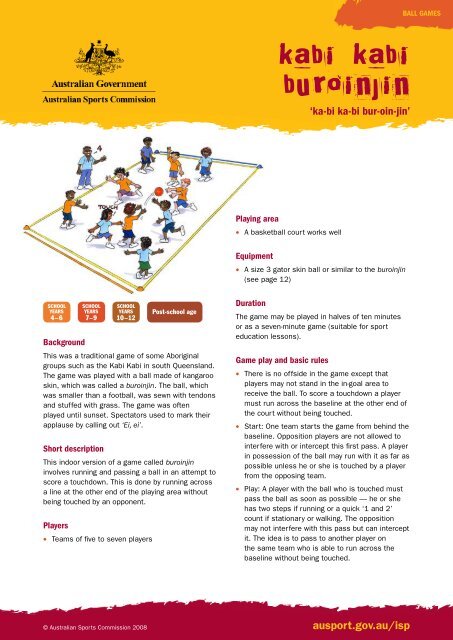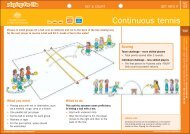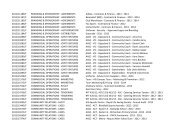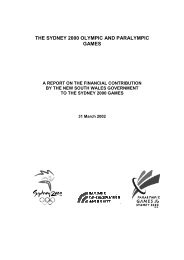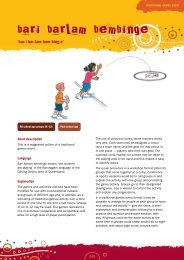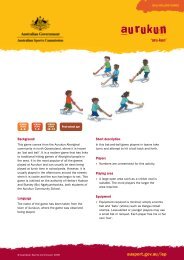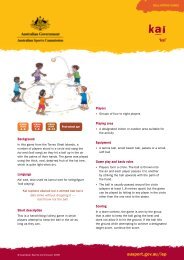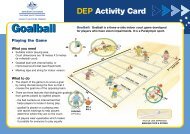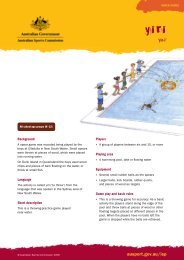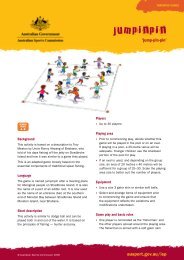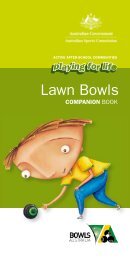Kabi kabi buroinjin - ball games - Australian Sports Commission
Kabi kabi buroinjin - ball games - Australian Sports Commission
Kabi kabi buroinjin - ball games - Australian Sports Commission
You also want an ePaper? Increase the reach of your titles
YUMPU automatically turns print PDFs into web optimized ePapers that Google loves.
School<br />
YearS<br />
4–6<br />
Background<br />
School<br />
YearS<br />
7–9<br />
School<br />
YearS<br />
10–12<br />
This was a traditional game of some Aboriginal<br />
groups such as the <strong>Kabi</strong> <strong>Kabi</strong> in south Queensland.<br />
The game was played with a <strong>ball</strong> made of kangaroo<br />
skin, which was called a <strong>buroinjin</strong>. The <strong>ball</strong>, which<br />
was smaller than a foot<strong>ball</strong>, was sewn with tendons<br />
and stuffed with grass. The game was often<br />
played until sunset. Spectators used to mark their<br />
applause by calling out ‘Ei, ei’.<br />
Short description<br />
This indoor version of a game called <strong>buroinjin</strong><br />
involves running and passing a <strong>ball</strong> in an attempt to<br />
score a touchdown. This is done by running across<br />
a line at the other end of the playing area without<br />
being touched by an opponent.<br />
Players<br />
• Teams of five to seven players<br />
Post-school age<br />
Playing area<br />
<strong>kabi</strong> <strong>kabi</strong><br />
<strong>buroinjin</strong><br />
‘ka-bi ka-bi bur-oin-jin’<br />
A basket<strong>ball</strong> court works well<br />
© <strong>Australian</strong> <strong>Sports</strong> <strong>Commission</strong> 2008 ausport.gov.au/isp<br />
•<br />
Equipment<br />
• A size 3 gator skin <strong>ball</strong> or similar to the <strong>buroinjin</strong><br />
(see page 12)<br />
Duration<br />
The game may be played in halves of ten minutes<br />
or as a seven-minute game (suitable for sport<br />
education lessons).<br />
Game play and basic rules<br />
• There is no offside in the game except that<br />
players may not stand in the in-goal area to<br />
receive the <strong>ball</strong>. To score a touchdown a player<br />
must run across the baseline at the other end of<br />
the court without being touched.<br />
• Start: One team starts the game from behind the<br />
baseline. Opposition players are not allowed to<br />
interfere with or intercept this first pass. A player<br />
in possession of the <strong>ball</strong> may run with it as far as<br />
possible unless he or she is touched by a player<br />
from the opposing team.<br />
• Play: A player with the <strong>ball</strong> who is touched must<br />
pass the <strong>ball</strong> as soon as possible — he or she<br />
has two steps if running or a quick ‘1 and 2’<br />
count if stationary or walking. The opposition<br />
may not interfere with this pass but can intercept<br />
it. The idea is to pass to another player on<br />
the same team who is able to run across the<br />
baseline without being touched.<br />
BALL GAMES
• Touch: Every time a player is touched the referee<br />
will call out the touch count. When a team has<br />
been touched in possession four times (three<br />
times can be used in some competitions) the<br />
opposing team will gain possession of the <strong>ball</strong><br />
where the final touch was made. Minimum force<br />
must be used on all touches.<br />
• Infringements: For any infringements the opposing<br />
team will take possession of the <strong>ball</strong> and pass to<br />
another player — no interference or interception<br />
is allowed on this pass. If a player runs out over<br />
a sideline, the other team gains possession on<br />
the sideline, whether he or she has been touched<br />
or not.<br />
• Passing: The <strong>ball</strong> may be passed in any direction<br />
and may be played (including a bounce pass)<br />
off the floor. The <strong>ball</strong> may not contact a player<br />
below the knees (change of possession). For<br />
safety reasons no players will be allowed to dive<br />
on the <strong>ball</strong> on the court and the <strong>ball</strong> may not be<br />
contacted with the fist but can be tapped or hit to<br />
another player using the flat of the hand.<br />
• A touch on the <strong>ball</strong> will count but a defender<br />
cannot hit the <strong>ball</strong> from the hands of the player<br />
with the <strong>ball</strong>.<br />
• When an intercept or loose <strong>ball</strong> is retrieved by the<br />
opposing team, play continues unless there is no<br />
advantage. (If a player or the <strong>ball</strong> goes out over the<br />
sideline then there is a throw-in to the other team.)<br />
• If an attacking player is touched and crosses<br />
the baseline, the opposing team starts with the<br />
<strong>ball</strong> from behind the baseline. After a touchdown<br />
(score) is made, the defending team re-starts play<br />
from behind its own baseline.<br />
• Replacements may be made at any time. A<br />
player leaves the court across the sideline<br />
and makes contact with the player who is to<br />
replace him or her.<br />
• Players who do not play in the spirit of the rules<br />
are to be sent off the court for a designated<br />
period of time without being replaced. A free<br />
throw for an infringement is taken from the<br />
place where it occurred on the court and must<br />
pass at least 3 metres to another player. (For all<br />
free throws defenders must move away at least<br />
3 metres.)<br />
•<br />
An advantage rule applies in the game.<br />
• Depending on the situation, players may at<br />
the next opportunity be sent from the playing<br />
area — at the discretion of the referee — for<br />
a designated period of time for a breach of<br />
the rules.<br />
• If a player runs with the <strong>ball</strong> behind the team’s<br />
baseline and is touched, possession goes to the<br />
opposing team 5 metres out from the line. For<br />
safety reasons an in-goal area of 3–5 metres<br />
may be marked.<br />
Comment<br />
This game may be used as a variation for the<br />
sport of touch foot<strong>ball</strong>. The game usually proves<br />
to be popular and involves a good deal of activity<br />
and involvement. It is possible to have two teams<br />
playing and a team ready to rotate after a period<br />
of time (usually five to seven minutes) as part of a<br />
sport education program.<br />
Variations<br />
• A set number of players or passes (such as four)<br />
must handle the <strong>ball</strong> for a team to score.<br />
• To avoid defenders placing themselves along<br />
the defensive line, players in a team may be<br />
restricted to attacking or defending parts of the<br />
court.<br />
Teaching points<br />
• Teams ready. Start behind the line. First pass is a<br />
free pass.<br />
• Everyone keep moving. Watch out for other<br />
players. Go.<br />
• Run and pass. Call the touches. Keep going.<br />
Play on.<br />
• Touch 1, touch 2, touch 3, touch 4. Change over.<br />
• Keep going. Call for the <strong>ball</strong>. Hands up to catch<br />
the <strong>ball</strong>.<br />
• Keep the game fast. Move to space.<br />
No interference defenders.


